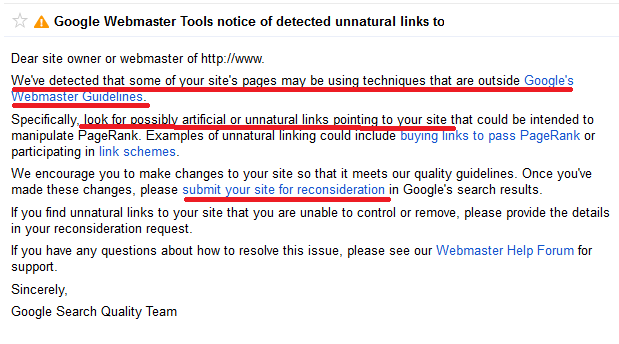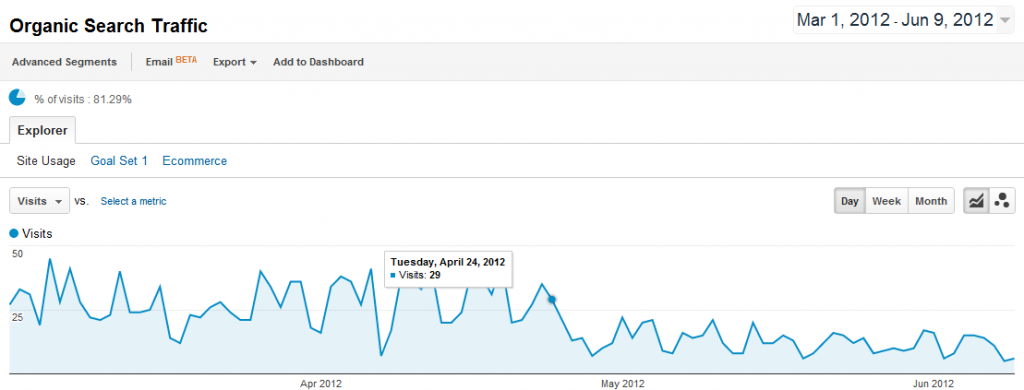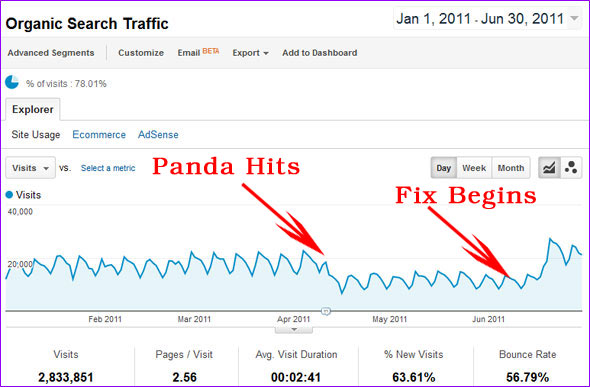The following article provides key information about the various types of Google penalties, how to detect if a site has been hit by a Google penalty and some tips on how to recover.
What is a Google Penalty?
Technically speaking, a Google penalty is when a search engineer from Google gives you a manual penalty for violating one of Google’s Webmaster Guidelines. There’s a number of ways that you can violate Google’s guidelines, including but not limited to backlink manipulation, mass guest posting, over optimized anchor text, hidden text links and doorway pages. You can see the whole list of topics here.
However, in addition to manual penalties, Google also has automatic filters that remove low quality sites or sites breaking their guidelines in the search results. Although Google refuses to class these as “penalties” because they are automatic filters as opposed to manual class actions, they still have the same affect of lowering your search engine rankings. Therefore, most SEOs still class these filters as “penalties”, “algorithmic penalties” or “algorithmic updates”. You can read more about manual vs. algorithmic penalties at SearchEngineLand.com here.
The Different Types of Google Penalties
Over the years, Google has had to develop numerous algorithms to counter web spam and the burgeoning black hat SEO industry. For instance, competitive industries such as payday loans are notorious for breeding webspam and blackhat SEO.
As such, Google has built numerous types of penalties and filters into its algorithms. The main ones are discussed below.
1. Manual Penalty or Spam Action
What is it? A manual penalty is the most common type of Google penalty that a Webmaster will come across. A manual penalty occurs when a member of Google’s Search Quality Team manual reviews your site and sees that it has violated one of Google’s Webmaster Guidelines.
According to Google, only 0.22% of websites on the Internet have received manual actions, however most people that have been in SEO for long enough will have experienced a manual action in one form or another.
What’s the Result? Upon receiving a manual penalty, Google now sends an alert to all webmasters hit with a manual action in Google Webmaster Tools (note that if you don’t have your site verified in Webmaster Tools than you won’t receive a message).

1-3 weeks after receiving a manual action, your site will normally lose all of its organic SEO rankings. Sometimes this will be indefinitely and sometimes the penalty will expire after 3-6 months. The severity of the penalty usually depends on the seriousness of the violation. Matt Cutts at Google has stated that most penalties applied to websites have a fixed expiry time. Furthermore, penalties become more severe for repeat offenders
How to Fix it: In order to fix a penalty you’ll need to make changes to your website and fix whatever guidelines you violate with Google’s Webmaster Guidelines. This usually involves cleaning up your bad links with the help of a backlink monitoring tool.
Once you’ve done this, you’ll need to file a reconsideration request with Google (this is found in your Webmaster Tools account) that explains all of the actions you’ve taken to bring your site back in line with Google’s guidelines.
If you were penalized for buying links or link manipulation, you’ll need to remove or disavow the bad links before filing the reconsideration request (you’ll need to manually remove at least 40% of the bad backlinks). Once you’ve submitted your reconsideration request, you should here back within 1-2 weeks with the outcome.
2. Penguin Update (Algorithmic Penalty)
What is it? The Penguin update was launched on April 24th 2012 and is a day that will live in infamy for most SEOs. The Penguin update targeted sites that had violated Google’s Webmaster guidelines (specifically Link Schemes such as over optimized anchor text and paid links). At the time it was launched, Google said that it impacted a total of 3.1% of English query search results.
You can read more about the Penguin update on Google’s Official Webmaster Blog here.
What is the Result? The Penguin update is the most ruthless and shocking of all penalties. This is because it completely removes all of a website’s organic search rankings and is arguably 99% impossible to recover from. In fact, in the 2 years since Google launched the Penguin update, there have been only faintly rumored cases of recovery.

How to Fix It: Google’s Matt Cutts claims that if you remove the link scheme violations to your site than your site will resurface in the next Penguin update (when the data is refreshed). However, to date there are been virtually no proven cases of recovery. The notion that you can’t recover from the Penguin update is reinforced by Matt Cutt’s declaration that Google aims to “break the spirits of Blackhat SEO’s”.
In conclusion, if you’re hit by the Penguin update then you’re only realistic option is to start over on a new domain.
3. Panda Update (Algorithmic Penalty)
What is it? The Panda update is an algorithmic update that promotes high quality sites and reduces lower quality sites in the search results. The Panda update (also known as the Farmer update) was first launched on February 23rd 2011.
The original Panda update impacted 12% of search results and was designed to reduce low quality “content farms” and scraper sites in the search results. It is thought that this update was a direct response to the general criticism of Google’s search results at the time.
However, the Panda update has since incorporated far more signals and is thought to promote or reduce a site’s rankings based on additional signals such as user experience, page speed, content quality, uniqueness of content, brand signals, social signals and more.
Panda has a site-wide impact. This means that low quality quality content in one section of a site can bring the whole site’s ranking down.
Although the Panda algorithm was originally only updated once every 1-2 months (meaning webmasters had to wait months to recover once they had fixed their site), in June 2013, Google made Panda a core part of the main search engine algorithm, which means new data is now updated in real time.
What is the Result? Websites impacted by Google’s Panda update will see most of their rankings drop, and lose around 40-60% of their traffic from Google.

How to Recover: In order to recover from the Panda update, you’ll first need to identify the current potential issues on your site (e.g. low quality/duplicate content, slow page speed, poor site design, too many ads). You’ll then need to fix these issues and wait 2-3 months for your rankings to recover.
Unlike the Penguin update, the Panda update is thought to be easier to recover from for webmasters. In fact, in 2013 Google announced that it intended to “soften” the impact of the Panda algorithm and try to make it easier to recover from.
You can read an excellent recovery guide for the Panda update written by Marcus Taylor at VentureHarbour.com here.
Conclusion on Google Penalties
This page has explained the main Google penalties that impact webmasters, the impact that these penalties have, and the strategies needed in order to recover. For more information about Google penalties or to find out if your site was hit by a penalty then we recommend taking a look at the Google Algorithm Change History at Moz.com. You can also use the Panguin checker tool to see which updates impacted your site.
